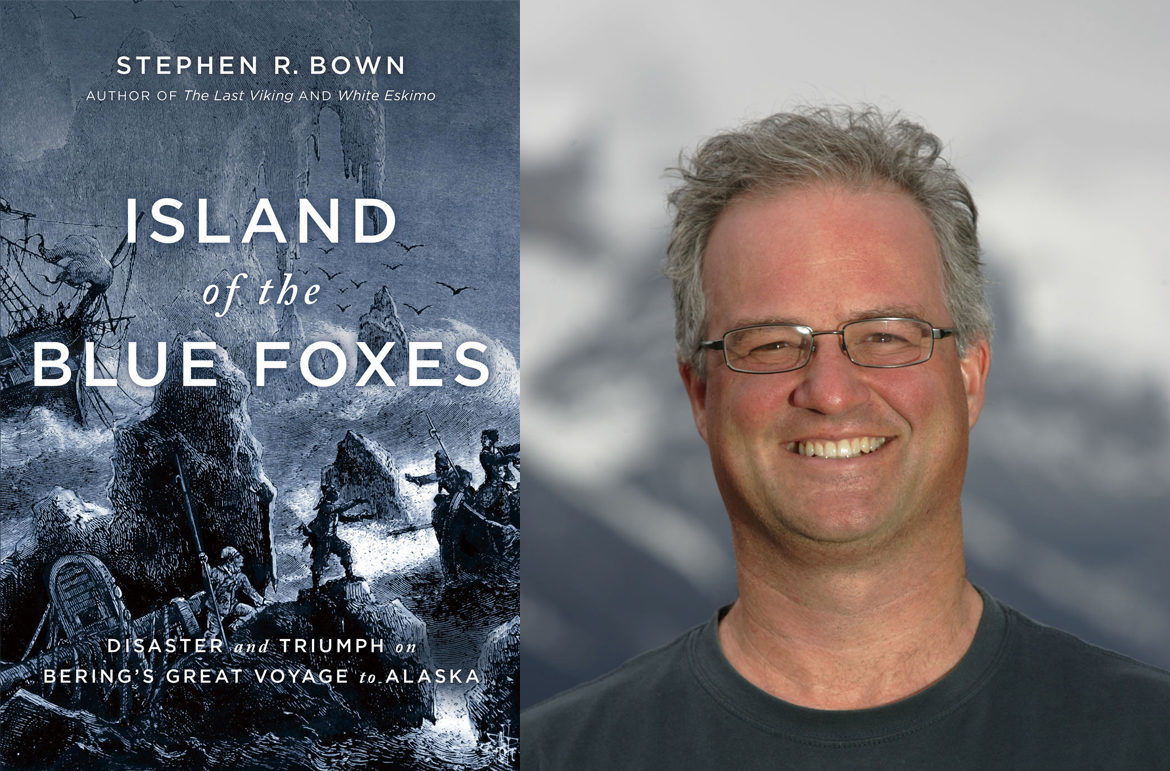The Great Northern Expedition was the most ambitious and well-financed scientific expedition in history. Lasting nearly ten years and spanning three continents, its geographical, cartographical, and natural history accomplishments have had a lasting impact.
Shortlisted for the RBC Taylor Prize and longlisted for the BC National Award for Canadian Non-Fiction, Island of the Blue Foxes: Disaster and Triumph on Bering’s Great Voyage to Alaska by Stephen R. Bown, recounts the Great Northern Expedition in a “rapidly paced story of adventure” that reads like gripping fiction.
You’ve written a number of historical non-fiction books. Where did the idea for Island of the Blue Foxes come from?
I’ve actually had the idea for years (I read about it somewhere in a book about Pacific America and knew right away it would make an incredible story), so I was just waiting for the right time to pursue it. Some new information came out – personal letters between Vitus Bering and his wife Anna Bering – and that was the final piece of the puzzle, to bring those characters alive.
Why did you think this would make an interesting topic for a book?
Well, the obvious reason is that it’s an incredible but little known true story of adventure from the Age of Sail that ended in a shipwreck on a deserted uncharted island in the Arctic in November. Also, it had never been done in a narrative fashion before – and yet it includes famous personalities like Peter the Great, Vitus Bering, and Georg Steller.
Island of the Blue Foxes has been shortlisted for the RBC Taylor Prize and longlisted for the BC National Award for Canadian Non-Fiction. How did you find out about the nomination and what was your reaction?
I was sipping my morning coffee on January 10 and getting my kids out the door for school (well, they are both teenagers now, but it still requires a bit of effort). I checked email and there was a message from Corina Eberle (National Publicity Director for my long-time publisher Douglas & McIntyre) titled “You’re on the list!”, so that was a pretty exciting morning.
What elements do you think historical nonfiction books need to be engaging narratives?
A strong focus on the people involved. The story is nothing without interesting and dynamic people faced with complicated challenges. In the case of Island of the Blue Foxes, a critical resource was the interesting and intimate journals from two key members of the expedition and plenty of other supporting information and shorter accounts. This is why it was possible to bring the story alive and make it relevant to people who might not otherwise care about the historical context. In fact, I actually find a dense historical background to be somewhat meaningless or hard to grasp without reading about the actual people and their struggles to humanize it, to show how life was lived and the limitations historical circumstances placed upon their lives.
“I actually find a dense historical background to be somewhat meaningless or hard to grasp without reading about the actual people and their struggles to humanize it”
You’ve been lauded for the historical reconstruction and narrative of your books. What’s your research process?
I read all the background history so that I understand the context, and I review whatever journals exist for the people involved in the story. Often gathering this information involves ordering obscure books from faraway places, sometimes in foreign languages, that must then be scanned and translated using online translation software. As I read, I make notes of all the things that seem interesting, insightful, or outrageous – things that make historical personages seem like living people – and then when I write, I do my best to fit in all in. Essentially, I look for the good parts and craft the story around them.
Did you make any surprising discoveries during your research?
Two surprising discoveries come to mind. First, I think Georg Steller may have been an alcoholic. His behaviour was outrageous and almost the caricature of an a** hole. But during the course of the voyage he underwent a dramatic transformation from an abrasive, pompous know-it-all, into a caring and oddly wise leader and advisor. The transformation comes about with the loss of the ship’s liquor supplies. After the voyage he becomes abrasive again and then dies of alcohol poisoning and exposure in Siberia.
I also learned that people must have been tougher back then than they are today. How else could they have survived what they did?
What details and elements do you seek to include in your books?
As I mentioned, anything interesting about the people becomes the skeleton that all else hangs upon, and also anything tactile – such as descriptions of the scenery, the smell and taste of food, the sounds of or antics of animals, etc. Anything that makes it obvious that the story happened in the real world with small everyday events and observations, and not just the big serious history of dates and implications.
What’s next? Do you have a topic you’re currently researching?
Of course! Something fascinating and dramatic and not done before (or at least in a very long time). I don’t want to say too much because I’m still in discussions with my agent and publishers.
Stephen R. Bown is the critically acclaimed, award-winning author of eight literary non-fiction books on the history of science, exploration, and ideas. White Eskimo was the winner of the 2016 William Mills Prize for Non-Fiction Polar Books. Madness, Betrayal and the Lash won the 2009 Bill Duthie Booksellers’ Choice Award and was also shortlisted for the Canadian Authors’ Association Lela Common Award for History. Stephen lives in the Canadian Rockies.
Photo credit: Craig Douce

